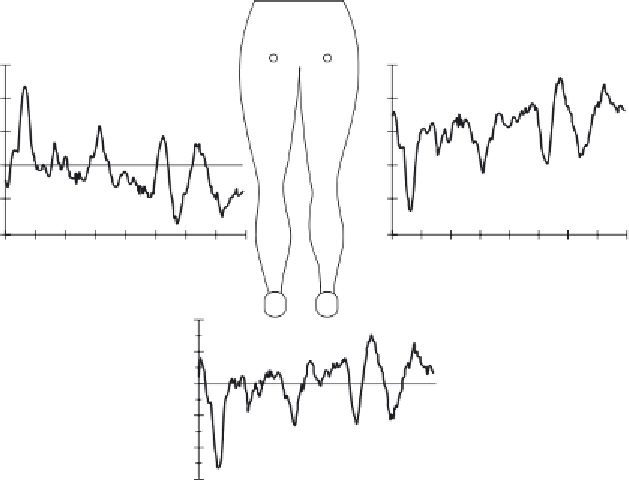Biomedical Engineering Reference
In-Depth Information
Left Vertical Reaction Force
Right Vertical Reaction Force
56
54
54
52
52
50
50
48
48
46
46
44
2468
TIME (s)
10
12
14
16
2468
TIME (s)
10
12
14
16
net
COP
−+
0.8
Copi
Copr
0.4
0
−
0.4
2
64 8
TIME (s)
M/L Displacement of COPnet
10
12
14
16
−
0.8
−
1.2
Figure 11.4
Left and right vertical ground reaction forces from two force platforms
from a subject standing quietly. Note that the left and right vertical reaction forces
oscillate about 50% of body weight and that these oscillations are virtually equal in
amplitude and exactly out of phase. The M/L COP is a weighted average of these
two reaction forces and with the convention shown is in phase with the right vertical
reaction force. See the text for details of this load/unload mechanism as a synergy to
maintain balance during quiet standing. (Reproduced with permission from Winter,
D. A., A. B. C.
Anatomy, Biomechanics and Control of Balance during Standing and
Walking
, Waterloo Biomechanics, 1995.)
error signal [Equation (11.3)] keeps accelerating the COM toward a central
position. This mechanism can be considered as a bilateral synergy because the
CNS has to keep the left and right hip abductors/adductors at a small level
of muscle tone so that the miniscule M/L sway results in small synchro-
nized fluctuations in hip frontal-plane moments sufficiently large to maintain
M/L balance. The fact that this balance mechanism does not involve con-
tinuous reactive control allows all the reactive sensors to be on “standby”
ready to react to an unexpected perturbation. One final question relates to
what causes the fluctuations in the COM. The COM in these studies was
estimated from a 14-segment total body model (see Section 4.1.7.2), which
included four trunk segments; this was necessary because of internal mass
shifts mainly from the lungs and heart (Winter, et al. 1966, Hunter and Kear-
ney, 1981).





















Search WWH ::

Custom Search